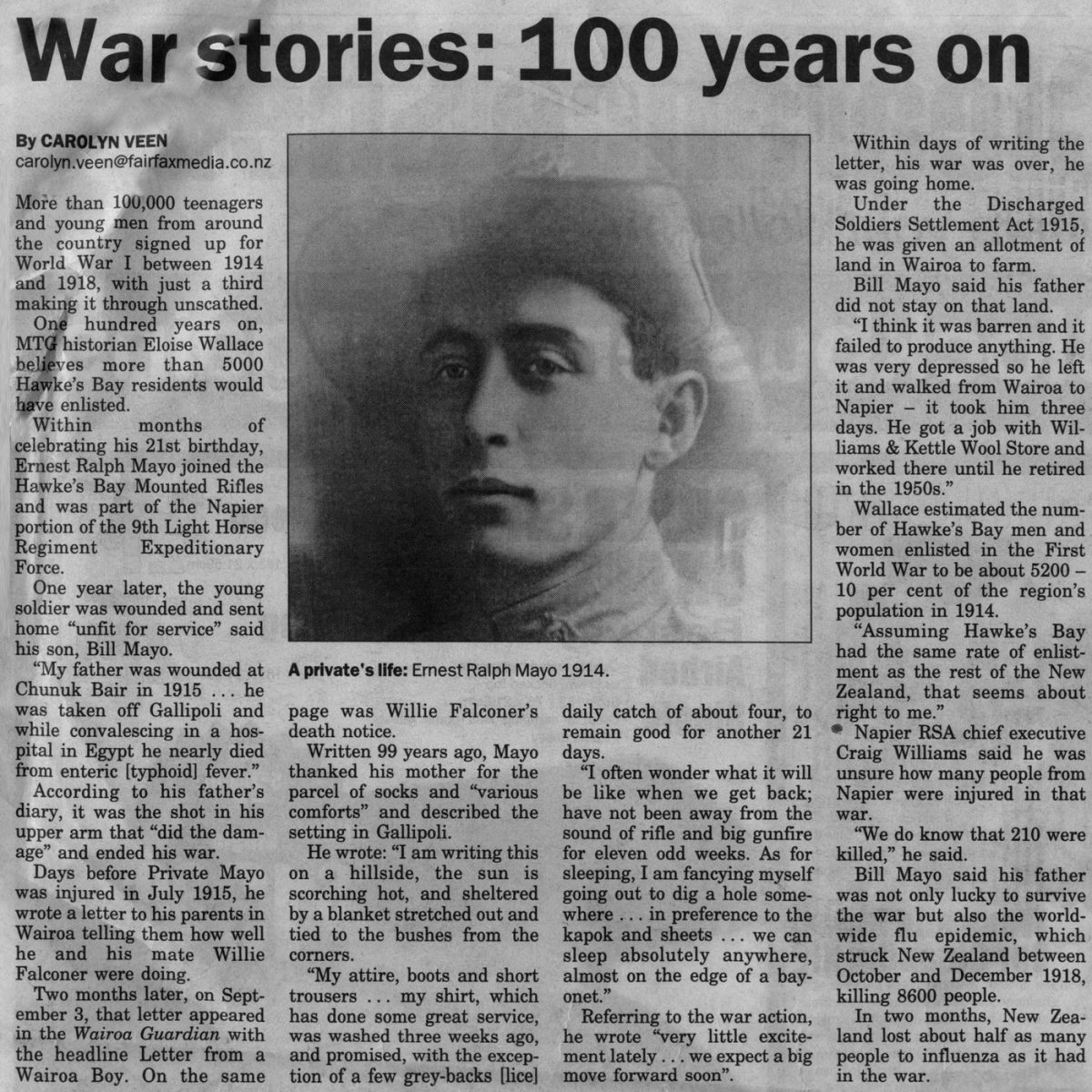War stories: 100 years on
By CAROLYN VEEN
[email protected]
More than 100,000 teenagers and young men from around the country signed up for World War I between 1914 and 1918, with just a third making it through unscathed.
One hundred years on, MTG historian Eloise Wallace believes more than 5000 Hawke’s Bay residents would have enlisted.
Within months of celebrating his 21st birthday, Ernest Ralph Mayo joined the Hawke’s Bay Mounted Rifles and was part of the Napier portion of the 9th Light Horse Regiment Expeditionary Force.
One year later, the young soldier was wounded and sent home “unfit for service” said his son, Bill Mayo.
“My father was wounded at Chunuk Bair in 1915 … he was taken off Gallipoli and while convalescing in a hospital in Egypt he nearly died from enteric [typhoid] fever.”
According to his father’s diary, it was the shot in his upper arm that “did the damage” and ended his war.
Days before Private Mayo was injured in July 1915, he wrote a letter to his parents in Wairoa telling them how well he and his mate Willie Falconer were doing.
Two months later, on September 3, that letter appeared in the Wairoa Guardian with the headline Letter from a Wairoa Boy. On the same page was Willie Falconer’s death notice.
Written 99 years ago, Mayo thanked his mother for the parcel of socks and “various comforts” and described the setting in Gallipoli.
He wrote: “I am writing this on a hillside, the sun is scorching hot, and sheltered by a blanket stretched out and tied to the bushes from the corners.
“My attire, boots and short trousers … my shirt, which has done some great service, was washed three weeks ago, and promised, with the exception of a few grey-backs [lice] daily catch of about four, to remain good for another 21 days.
“I often wonder what it will be like when we get back; have not been away from the sound of rifle and big gunfire for eleven odd weeks. As for sleeping, I am fancying myself going out to dig a hole somewhere ,. . . in preference to the kapok and sheets … we can sleep absolutely anywhere, almost on the edge of a bayonet.”
Referring to the war action, he wrote “very little excitement lately . . . we expect a big move forward soon”.
Within days of writing the letter, his war was over, he was going home. Under the Discharged Soldiers Settlement Act 1915, he was given an allotment of land in Wairoa to farm.
Bill Mayo said his father did not stay on that land.
“I think it was barren and it failed to produce anything. He was very depressed so he left it and walked from Wairoa to Napier – it took him three days. He got a job with Williams & Kettle Wool Store and worked there until he retired in the 1950s.”
Wallace estimated the number of Hawke’s Bay men and women enlisted in the First World War to be about 5200 – 10 per cent of the region’s population in 1914.
“Assuming Hawke’s Bay had the same rate of enlistment as the rest of the New Zealand, that seems about right to me.”
Napier RSA chief executive Craig Williams said he was unsure how many people from Napier were injured in that war.
“We do know that 210 were killed,” he said.
Bill Mayo said his father was not only lucky to survive the war but also the worldwide flu epidemic, which struck New Zealand between October and December 1918, killing 8600 people.
In two months, New Zealand lost about half as many people to influenza as it had in the war.
Photo caption – A private’s life: Ernest Ralph Mayo 1914.












Do you know something about this record?
Please note we cannot verify the accuracy of any information posted by the community.